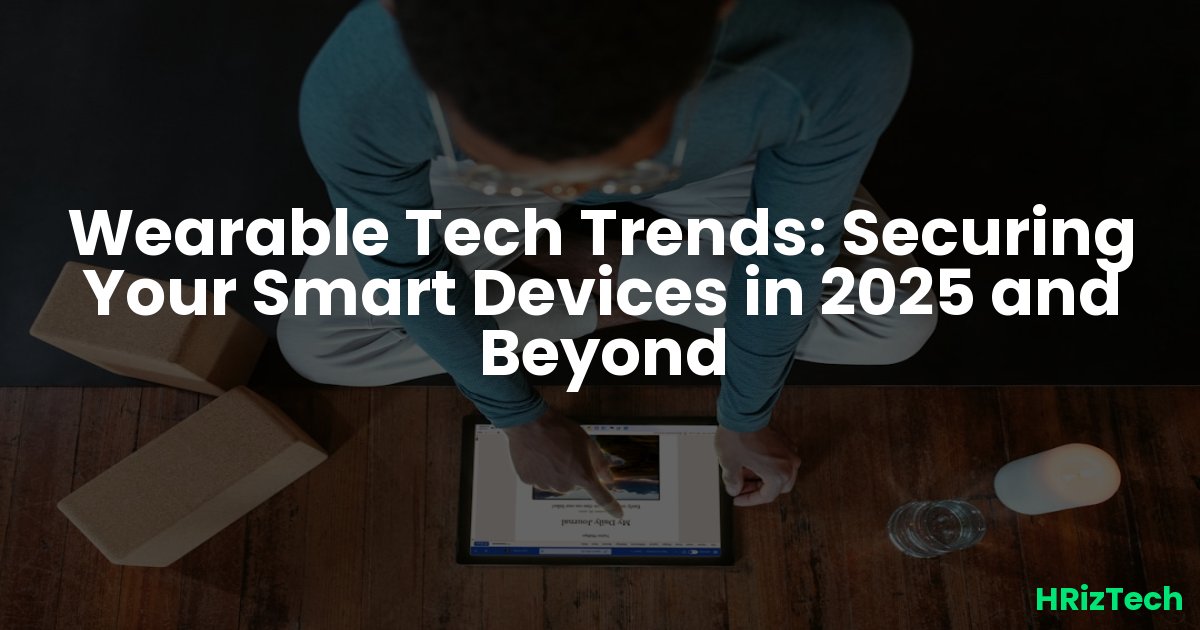Wearable Tech Trends: Securing Your Smart Devices in 2025 and Beyond
Did you know that by 2025, the global wearable tech market is projected to be worth hundreds of billions of dollars? That's a lot of smartwatches, fitness trackers, and other devices strapped to our wrists and bodies! This explosive growth in Wearable Tech Trends brings incredible convenience and health benefits, but it also raises serious cybersecurity concerns. Let's dive into the trends and how to stay safe.
The Rise of the Smart Everything (and the Security Risks)
Wearable technology is evolving rapidly. We're seeing more sophisticated devices capable of collecting and transmitting vast amounts of personal data – everything from our heart rate and sleep patterns to our location and even our biometrics. This data is incredibly valuable, making these devices prime targets for cybercriminals. Think about it: your smartwatch knows your daily routine, your fitness goals, and even where you live. That's a treasure trove of information for someone with malicious intent.
Understanding the Growing Threats
The biggest threats facing wearable tech users include data breaches, malware infections, and privacy violations. Hackers can exploit vulnerabilities in the devices themselves, the apps that connect to them, or even the networks they use to communicate. This can lead to identity theft, financial loss, and even physical harm. A 2025 Gartner report highlights the increasing sophistication of these attacks, predicting a significant rise in targeted phishing campaigns specifically aimed at wearable device users.
Wearable Tech Trends: AI and the Future of Security
One of the biggest Wearable Tech Trends for 2025 and beyond is the integration of Artificial Intelligence (AI) into wearable devices. AI can enhance security in several ways. For example, AI-powered threat detection systems can identify and block malicious activity in real-time. However, AI also presents new challenges. How do we ensure that AI-powered security systems are themselves secure and not vulnerable to attack?
AI's Double-Edged Sword
While AI can strengthen security, it also creates new attack vectors. Think about AI-powered biometric authentication systems. If these systems are compromised, the consequences could be severe. We need to develop robust security protocols to protect these AI systems themselves. The development of ethical and secure AI is crucial to mitigating these risks.
Protecting Your Personal Data: Practical Steps
So, how do you protect yourself in this brave new world of connected wearables? Here are some actionable steps you can take:
- Choose reputable brands: Opt for devices from well-established companies with a proven track record of security.
- Update your software regularly: Software updates often include critical security patches. Make sure your device and its associated apps are always up-to-date.
- Use strong passwords and two-factor authentication (2FA): This adds an extra layer of security, making it much harder for hackers to access your accounts.
- Be mindful of permissions: Review the permissions requested by wearable apps and only grant access to those you're comfortable with.
- Monitor your device's activity: Pay attention to any unusual behavior, such as unexpected battery drain or data usage spikes.
- Be wary of phishing attempts: Don't click on suspicious links or open attachments from unknown sources, especially those related to your wearable devices.
Wearable Tech Trends: The Importance of Privacy
Beyond security, privacy is a major concern. Wearable devices collect a wealth of personal data, raising questions about who has access to this information and how it is being used. Understanding your device's privacy settings and exercising control over your data is crucial.
Taking Control of Your Data
Review your device's privacy policy and settings. Understand what data is being collected, how it's being used, and with whom it's being shared. Many devices offer options to limit data collection or turn off certain features. Remember, your data is valuable, and you have the right to protect it.
Wearable Tech Trends and the Future: A Secure Path Forward
The future of wearable technology is bright, but navigating the security and privacy challenges is essential. By staying informed about the latest Wearable Tech Trends, taking proactive security measures, and advocating for stronger data protection policies, we can harness the benefits of these devices while minimizing the risks.
Have you experienced any security issues with your wearable devices? What are your biggest concerns regarding wearable technology and security?
What’s your favorite security tip for protecting your smart devices? Share below!

Comments
No comments yet. Be the first to comment!